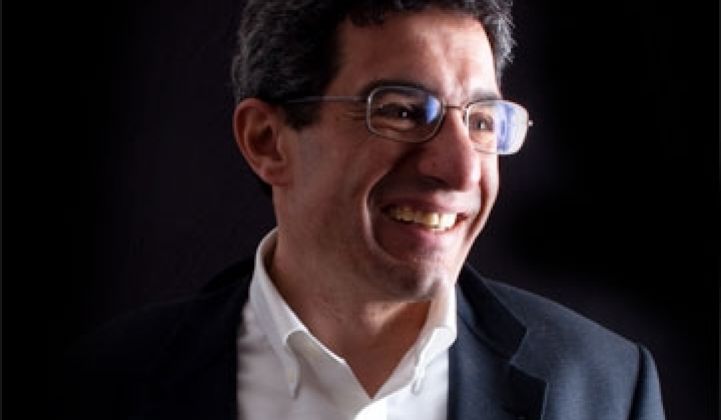A few months ago, I sat on a panel with PR exec Larry Weber, the founder of Weber Shandwick whose new company is W2 Group, when he asked me: "How do you define green technology?"
An evasive, rambling answer followed. Granted, I'm typically good for at least 25 incoherent pronouncements a day, but usually I only share them with family and co-workers.
The problem was that I had more than one answer. The green market can be divided in a large number of ways, depending on what you are trying to get at. Below is a list of some of the more handy ways to think of it.
1. The Nick Parker Unified Field Theory: "Cleantech is new technology and related business models that offer competitive returns for investors and customers while providing solutions to global challenges." It brought economics into the picture.
2. The Two Rs. Replace and Reduce: Do a company's products seek to replace fossil fuels, fertilizers or industrial chemicals with green technologies (solar turbines, synthetic chemicals generated by bacteria) or do they reduce the consumption of energy, water and raw materials. Some people add a third R-recycling-but recycling is essentially a subset of reduction.
While this cuts the market somewhat broadly, it has two advantages. One, it's the easiest to remember. Two, it gets to the heart of the main challenge they face. If it's a company that seeks to replace fossil fuels, the big hurdle is cost: Can whatever they are making compete with oil and coal? These are ultimately utilitarian companies. An electron from a wind turbine works as well as a coal plant does.
Replacement companies typically face a behavioral hurdle: will customers or businesses care enough to adopt it? Car sharing. LED lighting. New forms of public transportation. Forget economics: the real problems are skepticism and indifference. Some companies – electric cars and waste heat – actually fit in both categories.
3. The Three Disciplines – Biology, Chemistry and Physics: One of the more engaging aspects of greentech is the emerging impact of biology and chemistry. I reported on the IT industry for years and you rarely had a discussion about microbes. Biology seems to be the area with the greatest potential, with companies trying to exploit genes to produce biofuels (LS9, Microgy) industrial chemicals (Genomatica, Cambrios), fertilizer (Marrone Organics), air cleaners (Bio-Reaction, very cool stuff) and other materials. Intermolecular and Wildcat Discovery Technologies, meanwhile, want to port genetic screening tools to battery making.
Chemistry companies run the gamut from thermochemically derived ethanol, home cleaners to clean diesel powders (Nanostellar). In physics, you can lump anything to do with mechanics or electronics together: solar, wind, green IT, batteries, cars, etc.
If you're looking for a job, this is a way to help you determine where you might fit.
4. The Four Light Bulbs of Vinod: Everyone's seen the slide. Vinod Khosla divides the market into replacements for fossil fuels, replacements for coal, energy efficiency and materials. Informally, he also divides the market into two categories: sound concepts (his investments) and simpletons (yours).
It's one of the better ways to think about the market and can encompass pretty much everything. But things can straddle, Alsace Lorraine-like, into two groups. A company that makes energy efficient desalination equipment belongs in energy efficiency, but one like Oasys that produces forward osmosis membranes belongs in materials. Where do you put green cement – in efficiency or coal or materials? Still, it serves for most companies.
5. The Five Fingers of Greentech (Divide by Product and End Market) Transportation, Electricity, Building, Waste and Food/Water: You can also think of this as the Big Three (transportation, electricity and building) and the Two Dwarves because cars, power and buildings account for more than 70 percent of the investments. Smart grid is part of electricity and carbon capture is part of waste. (Minerals made from captured carbon can go into buildings or stay in recycling.) This is the categorization I developed while running the green section at CNET.
6. The Five Fingers of Greentech With Bonus Vestigial Tail Nub – Green Electronics: Hardware, software and networking often gets lumped into building because it largely revolves around energy efficiency, involves air conditioners, and because most computers and large-screen TVs aren't located outside. Green electronics, though, deserve their own category because the companies and circuit designers competing in this market constitute their own planet. The company behaviors, the technological roadmap, the economic considerations and the personalities of the people running the companies are very distinct. The category includes people who make servers, but also TV makers and appliance vendors. Often, like in the case with LG and Samsung, single companies serve all three markets with some technological overlap.
Electronics also only constitute a small problem for buildings. Computers account for 4 percent of energy consumption in commercial buildings, according to the Buildings Energy Book from the Department of Energy, or as much as refrigeration. Lighting accounts for 25 percent, more than six times as much power. Separating it out prevents it from getting lost.
7. The Seven Samurai: Add consumer to that last one. Consumer remains a market that needs to take off. Surveys show that consumers want greener household cleaning products, but they often aren't willing to pay for it. Volume production of things like green house cleaners and carbon taxes could change this. Pepsi and others will also launch greening household products invisibly by swapping out bisphenol in cans.
A few clever ideas – such as the green dry-cleaner hangers subsidized by ads from Vesta – have emerged as well. Still, it's a "to-be-determined" situation.



